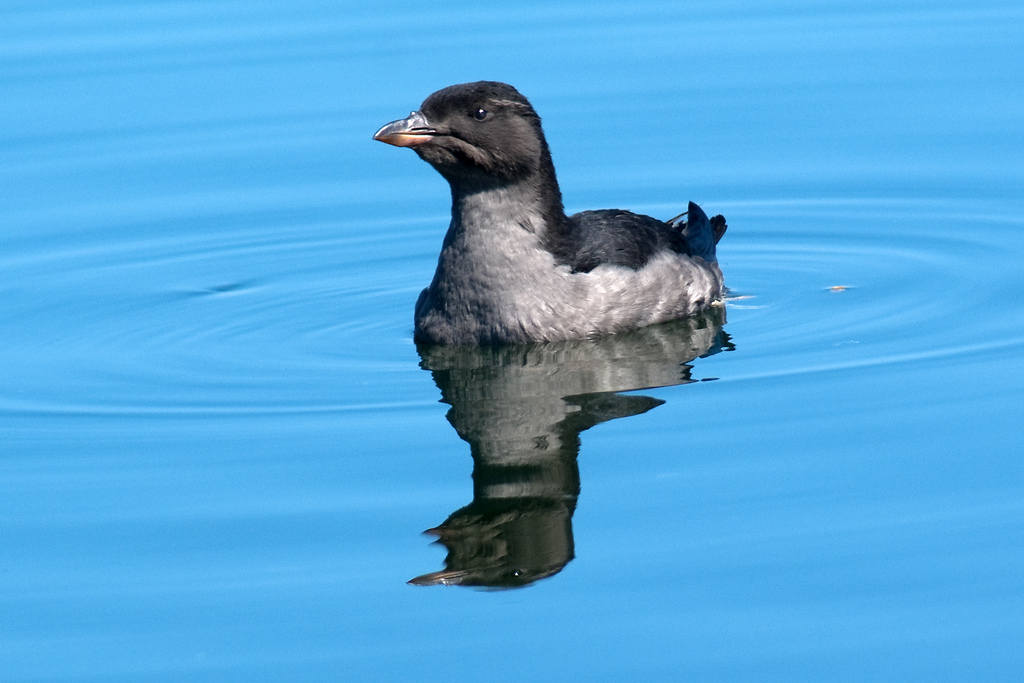 Marine birds are important sentinel species for ecological conditions and to track them, scientists often count the birds at the breeding colonies, which tells us the number of adults trying to breed.
Marine birds are important sentinel species for ecological conditions and to track them, scientists often count the birds at the breeding colonies, which tells us the number of adults trying to breed.
But for seabirds that nest in burrows like Rhinoceros Auklets and Tufted Puffins, it’s hard to know how big the colony is because the birds, eggs, and chicks can be 15 feet down underground.
A recently-published SeaDoc-supported paper recommends ways to improve monitoring of burrow-nesting seabirds. Lead author Scott Pearson and others used Rhinoceros Auklet breeding colony count data for the last 40 years to evaluate ecosystem changes and to address how scientists can best estimate colony size for burrow-nesting seabirds.
If Scott Pearson’s name is familiar, it’s because he worked with Joe Gaydos on our landmark list of birds and mammals of the Salish Sea. (Publication/Checklist)
The goal of the study was to develop a precise and repeatable method so that population trends for burrow-nesting seabirds could be tracked. Historically, researchers have used different statistical tools and sampling methods over time to monitor burrow-nesting seabirds, which makes data sets hard to compare to each other.
The paper contained two items we think are of particular interest to non-scientists. The first was that contrary to expectations, the population of Rhinoceros Auklets is increasing at two locations in the Salish Sea, but declining on an island off the outer coast of Washington State.
The second was the authors’ cautionary statement that marine bird populations need to be assessed during similar oceanographic conditions. For example, unusual conditions like those present in the summer of 2005 can cause mass-abandonment of nesting areas and comparing years like this to years when oceanic conditions are better doesn't really paint a clear picture of trends. You get a better picture of the real trend in nesting birds when you compare apples to apples (good years to good years or bad years to bad years).
The monitoring, management and restoration implications for this research are that it provides a repeatable and statistically robust approach to monitoring burrow nesting seabirds that can be applied at single- or multi-island scales. The beauty is that the approach can be applied to both relatively common and important members of the seabird community like the Rhinoceros Auklet and to species of conservation concern like the Tufted Puffin. Also of note is that the authors provide an approach for simultaneously gathering and identifying habitat information that influences burrow density. This habitat information can in turn be used to inform restoration activities or it can be used to provide insights into observed colony trends.
(SeaDoc was one of many sponsors of this work. Other sponsors include the US Fish & Wildlife Service, Washington Department of Fish & Wildlife, Northwest Fisheries Science Center, and the University of Puget Sound.)
Citation: http://www.seadocsociety.org/node/753
Abstract: We present a prototype monitoring strategy for estimating the density and number of occupied burrows of burrow-nesting seabirds. We use data and management questions from Washington State as an example that can be applied to burrow-nesting seabirds at single- or multi-island scales. We also demonstrate how habitat assessments can be conducted concurrently. Specifically, we compared the density and occupancy of burrows of the Rhinoceros Auklet (Cerorhinca monocerata) at nesting colonies in the California Current and the Salish Sea and in the 1970s, 1980s, and today. We estimated 36 152, 1546, and 6494 occupied burrows on Protection and Smith islands (Salish Sea), and De- struction Island (California Current), respectively. Our estimates for the Salish Sea are 52% greater than those from the 1970s and 1980s, while that for the California Current is 60% less than that of 1975. This suggests that the Salish Sea population has increased, despite greater human effects on that ecosystem. However, some of the estimated changes between the periods could be the result of methodological and analytical differences. To address these issues we recom- mend an unbiased and representative sampling approach (stratified random) and an approach for optimally allocating the samples among strata within and among islands, depending on the scale of the question being addressed. Optimally allocating the sample would save a great deal of field effort; using this approach, we achieve relatively high power (>0.80) to detect moderate changes (20%) sampling hundreds of fewer plots than in a sample not optimally allocated.
Photo by USFWS Pacific.


